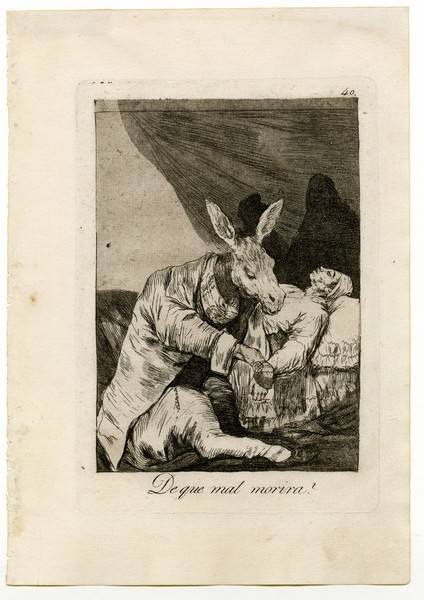- Cronología
- Ca. 1797 - 1799
- Dimensiones
- 216 x 152 mm
- Técnica y soporte
- Aguafuerte, aguatinta bruñida, punta seca y buril
- Reconocimiento de la autoría de Goya
- Undisputed work
- Ficha: realización/revisión
- 14 Dec 2010 / 29 May 2024
- Inventario
- 225
De que mal morira? (at the bottom)40. (in the upper right-hand corner)
See Francisco de Goya y Lucientes, Painter.
In the first printings the title appears without a question mark until the error was corrected.
Two preparatory drawings for this engraving have survived (1) and (2).
A donkey dressed in a suit takes care of a dying man who has his mouth ajar, as if he were in agony. He grasps the man's wrist with his hoof on which an ostentatious ring can be seen. The animal seems to be really concentrating on what he is doing, his expression is serious and meditative, although he has not removed the jewel that could prevent him from carrying out his task properly. In the background, Goya has depicted the shadows of two figures awaiting the doctor's verdict for the sick man who has little chance of overcoming his illness.
The manuscript in the National Library provides a clear and concise reading of this engraving, which reads as follows: "It is not necessary to ask what ailment the sick person who pays attention to beastly and ignorant doctors has died of".
Francisco Gómez de Quevedo (Madrid, 1580 - Villanueva de los Infantes, 1645) had already pointed out the lack of training with which doctors approached their profession in his Sueño, Visita de los Chistes: "(...) dealing more with mules than with Doctors, they graduated as Doctors". Somewhat further on, he insists: "If these others are made of these, it is not much that these others will unmake us".
The 18th century was a time of great advances in medicine. It was precisely at this time that figures such as the Englishman William Cullen (Hamilton, Lanarkshire, 1710-Edinburgh, 1790) and the Danish Hermann Boerhaave (Voorhout, 1668-Leiden, 1738) emerged. In Spain, the contributions of Andrés Piquer y Arrufat (Fórnoles, 1711-Madrid, 1772) should be highlighted. In addition, during the reign of Charles III, in 1771, the medical teaching at the University of Salamanca was revised and updated on the basis of Boerhaave's contributions.
In this engraving Goya lashes out harshly against doctors and the ignorant, but also against the imprudence of those who put themselves in their hands. Thus, the title of the print questions whether the cause of death was the illness or the incompetence of the doctor.
In some cases this image has been interpreted as a veiled reference to Manuel Godoy (Badajoz, 1767 - Paris, 1851) and the nefarious manner in which he governed the country.
This engraving forms part of the group of prints known as "asnerías", between 37 and 42, in which the images feature donkeys that serve to censure human stupidity.
The plate has a scratch on the upper part from the first edition (National Chalcography, no. 211).
-
Goya dans les collections suissesFundación Pierre GianaddaMartigny1982consultant editor Pierre Gassier. From June 12th to August 29th 1982cat. 51
-
Goya. La década de Los CaprichosMadrid1992organized by Real Academia de Bellas Artes de San Fernando sponsored by Fundación Central Hispano, Madrid, consultant editor Nigel Glendinnig. From October 26th 1992 to January 10th 1993cat. 138
-
Francisco de GoyaMuseo d'Arte ModernaLugano1996exhibition celebrated from September 22nd to November 17th.cat. 40, p.67
-
Francisco Goya. Sein leben im spiegel der graphik. Fuendetodos 1746-1828 Bordeaux. 1746-1996Galerie KornfeldBern1996from November 21st 1996 to January 1997cat. 46
-
Goya e la tradizione italianaFondazione Magnani RoccaMamiano di Traversetolo (Parma)2006consultant editors Fred Licht and Simona Tosini Pizzetti. From September 9th to December 3th 2006cat. 40, p.155
-
Goya. Opera graficaPinacoteca del Castello di San GiorgioLegnano2006exhibition celebrated from December 16th 2006 to April 1st 2007p.33
-
Goya et la modernitéPinacothèque de ParisParís2013from October 11st 2013 to March 16th 2014cat. 145
-
Goya engravings and lithographs, vol. I y II.OxfordBruno Cassirer1964p.112, cat. 75
-
Vie et ouvre de Francisco de GoyaParísOffice du livre1970p.181, cat. 529
-
Goya, la década de los caprichos: dibujos y aguafuertesMadridReal Academia de Bellas Artes de San Fernando1992pp.228-231, cat. 136-138
-
Catálogo de las estampas de Goya en la Biblioteca NacionalMadridMinisterio de Educación y Cultura, Biblioteca Nacional1996p.95, cat. 129
-
El libro de los caprichos: dos siglos de interpretaciones (1799-1999). Catálogo de los dibujos, pruebas de estado, láminas de cobre y estampas de la primera ediciónMadridMuseo Nacional del Prado1999pp.226-229
-
Francisco Goya. Los CaprichosBarcelonaEdiciones de la Central2011pp.46-47
-
ParísPinacoteca de París2013p. 207
-
Goya. In the Norton Simon MuseumPasadenaNorton Simon Museum2016pp. 42-75


